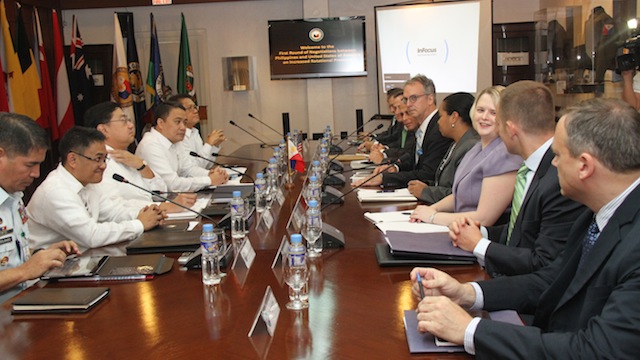SUMMARY
This is AI generated summarization, which may have errors. For context, always refer to the full article.
MANILA, Philippines – What message is the Philippines sending to China following a deal allowing increased rotational presence of US troops in the Philippines?
Malacañang Palace says China can interpret it on its own.
On Monday, March 17, Presidential Spokesperson Edwin Lacierda said the Philippines does not need to send a message. (READ: PH to press ‘equal access’ to US facilities in bases deal)
“Let China interpret that particular [deal],” Lacierda said at a press briefing. “The medium is the message.”
He did admit, however, that while the Visiting Forces Agreement (VFA) was sealed before the Philippines clashed with China, the rotational presence of Americans on Philippine soil “certainly would help” with regards to the country’s territorial conflict with China. (READ: PH, US haggling over length of stay of troops)
“The reason why it helps is because there’s some technology transfer, there’s knowledge sharing between the American forces and the Philippine forces when they do conduct military exercises,” he said. “It improves the quality of the Philippines in terms of preparedness.”
The Philippine panel negotiating a new military-to-military agreement with the US presented to the Americans a “full draft text” a month before the scheduled visit of US President Barack Obama to Manila in April.
The agreement seeks the assistance of the US, a treaty ally, against the backdrop of rising tension with China over maritime disputes in the West Philippine Sea (South China Sea).
Tension continues to escalate as the Philippines filed another protest against China, after the rising superpower admitted it drove away 2 Filipino ships from Ayungin Shoal, which the Chinese call the Ren’ai Reef.
The US, for its part, said it is “troubled” by the Ayungin incident.
“This is a provocative move that raises tensions. Pending resolution of competing claims in the South China Sea, there should be no interference with the efforts of claimants to maintain the status quo,” State Department spokeswoman Jen Psaki said.
(READ: ‘Even during storms, China harassed Filipinos’)
The show of force happened less than a month after the Armed Forces of the Philippines revealed the so-called “water cannon incident” also involving the Chinese.
The deadline for the Philippines’ memorial, or written pleading in the country’s historic case against China, is on March 30. (READ: PH faces major hurdle in China case)
Ratification needed?
The government has said a new military deal between the Philippines and the US does not require Senate approval, but several lawmakers have said the agreement might raise constitutional questions.
Recently, Senator Miriam Defensor-Santiago, chairperson of the Senate foreign relations committee, said the agreement allowing wider and more prolonged US military access to Philippine bases should be considered a treaty, requiring concurrence of the Philippine Senate.
The senator said the Philippines cannot consider the deal as an executive agreement because executive agreements only carry out the details of a prior treaty.
On Monday, Lacierda defended the government’s position, maintaining the deal does not need to be ratified.
“It is an agreement that builds upon and implements the provisions of the Mutual Defense Treaty as well as Visiting Forces Agreement. Both agreements have been ratified by the Senate,” he said.
“So in the view of the Executive branch, these are mainly provisions which implement both treaties which have already been previously ratified by the Senate.” – Rappler.com
Add a comment
How does this make you feel?

There are no comments yet. Add your comment to start the conversation.